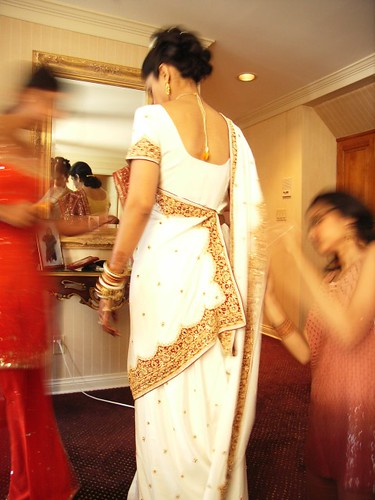By : Neha Chawla
Gujarat is a state of rich culture. Gujaratis reflect Indian heritage beautifully because of their customs, rituals and traditions. And when it comes to Gujarati weddings, they celebrate all the rituals that are part and parcel of the traditional Gujarati wedding.
In Gujarat, there are many rituals that serve as guidelines to the prospective couple on how to lead a happy married life. After the marriage, the Gujarati wife becomes her husband's sahdharmacharini or equal. Like all other Indian matrimonial communities, Gujaratis believe that with marriage comes responsibility and power. In fact, it is the wife who must keep house and look after all the household requirements.
Gujarati Matrimony:
Gujaratis prefer making matches of their sons and daughters with the communities. Similar to other Indian communities, the parents of the girl look for their daughter's husband as soon as she grows up. Gujaratis believe that the boy and girl should meet and see each other before taking the decision of marrying or not marrying.
Costumes:
Bridal wear:
Sari is the usual bridal wear for the Gujarati brides. Though, during the occasion, sari is worn in a different kind of style. Red is the most preferred as it considered being the most auspicious colour for the occasion. These days, designer lehengas are also a popular dress code during the weddings.
Groom’s attire:
Traditionally, the Gujarati bridegrooms are supposed to wear traditional Kurta and dhoti but these days, designer and formal suits or kurta pajamas have become a popular choice.
Rituals before the wedding:
Before the wedding, there are many rituals which are performed:
Mandap Mahurat:
This ceremony is performed to seek blessings of Lord Ganesha, the Hindu God who is believed to remove all obstacles. This is performed a few days before the wedding by the family of the bride and groom.
Griha Shanti:
This is an important ceremony during which a puja or prayer is performed and is conducted at the both the bride's and the groom's home. It is usually performed at an auspicious time after matching the horoscopes of the prospective bride and groom. The puja for Griha Shanti is usually conducted by an acharya along with the family members and relatives of the bride's father participating in the rituals.
Jaan:
During this interesting ritual, the groom arrives at the house of the bride to seek the blessings of his mother-in-law. As a custom, the groom is supposed to bow his head and clutch his nose. This gesture not only symbolizes his humility but also understanding of the tremendous sacrifice that his future wife is about to make. The groom's would-be mother-in-law blesses him and does a small act to ward off the evil eye. She also plays and tries to catch his nose by which she reminds him that he is the taker since he will be taking her daughter away and they are the givers.
Rituals during the wedding:
A number of beautiful and colorful rituals make Gujarati wedding different from other Indian weddings.
Antarpaat:
According to this custom, the bride's maternal uncle (mama) is supposed to carry the bride to the mandap. Then, the curtain known as Antarpaat, which separates the bride and groom is lowered and the couple garland each other.
Madhuparka:
After the Jaimala ceremony, Madhuparka takes place. During Madhuparka, the groom’s feet are washed by his sister-in-law. Then, he is offered milk and honey. This is followed by the most exciting custom, wherein the groom's sisters-in-law steal his shoes and hide away. This ritual is performed in almost all the Indian weddings where the groom and his brothers have to get back those shoes at the end of the day and for this the groom has to offer his sister-in-laws some money and other gifts.
Hasta Milap:
In this ritual, groom’s scarf is tied to the bride’s sari. This knot symbolizes the union of two souls in matrimony. Then, the acharya chants mantras to invoke the blessings of Goddess Lakshmi and Goddess Parvati for the saubhagyavrata or wife. On the other hand, the two families come together to bless the couple and shower grains of rice and rose petals on them.
Kanya Daan:
The proceedings of the wedding begin with the kanya daan where in the bride is given away by her parents. They fold their hands during the ceremony, which reflects the hope that their son-in-law will take good care of their daughter and never cause her pain.
Pheras:
In this ritual, the couple goes around the sacred fire and the acharya recites the mantras. The groom also repeats these mantras while expressing his heart's desire that seeks the loving support of his wife.
Saptapadi:
This means that the couple must go around the holy fire seven times. The groom keeps on chanting mantras with each step. These are requests to his wife to take good care of the house, cook healthy and nutritious meals for their family, be judicious with money, be an understanding and loving partner to him, etc. And the bride promises to fulfill these requests.
Then, both of them get tied in the most sacred bond – marriage. After this, a few post-wedding rituals are followed, which complete a beautiful Gujarati wedding.
About The Author-- Sukhpreet Kaur writes on behalf of Jeevansathi.com, which is India’s fastest growing matrimonial website, provides online Indian matrimonial classified services. Jeevansathi.com enables users to create a Gujarati matrimony profile on the website and allow prospective grooms and brides to contact each other. Users can search for profiles through advanced search options on the website. Users can avail free registration and make initial contact with each other through services available on Jeevansathi.com via Chat, SMS, and e-mail.
